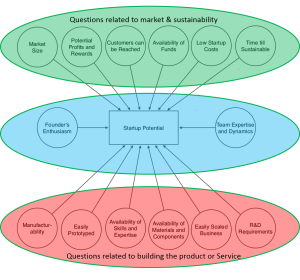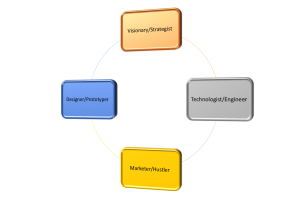This past year I have had numerous teams that had two or three startup ideas. Some of the teams want me to make the decision on what project to select. Most of them, however, just want some guidance on what questions to ask.
In its simplest form, the questions should relate to the economic, market, financial, operational and technical feasibility aspects of the idea, along with the characteristics of the founder(s). Here is a list of 14 questions to consider when weighing-in on an idea for a start-up (Figure 1).
Figure 1: Questions related to Start-Up Potential
Questions related to market and business sustainability
Many investors and founders look at the size of the market and the potential profits as the critical criterion for investing in a startup. But a startup must be able to capture part of that market and reach those customers through a marketing campaign. In order to become a viable sustainable business, funds are needed to launch the business, regardless of whether they come from the founders, family, friends or investors. If the startup costs for the business are low relative to the availability of funds then the business may eventually exist as a sustainable entity. The enemy is the burn rate or burning cash and not having funds to pay the bills. Long term sustainability is very difficult unless there is some way to obtain recurring revenues in the form of complementary products and services and refreshing the product line through R&D.
- Q1. How large is the market?
- Q2. Will the business be able to capture some of the market and realize a profit?
- Q3. Can the customers be readily identified and reached?
- Q4. Can funds be secured for starting the company?
- Q5. Are the startup cost relatively low?
- Q6. Is the time till the company is sustainable short?
Questions related to building the product or service
These questions relate to manufacturability, which is the ability of the startup to make the product and in the case of services, to set up processes that will be used to deliver a service. These questions are related to the ability of a start-up to develop a viable supply chain. A good indication of degree of manufacturability is whether or not a realistic prototype can be built. The key is to be able to obtain raw materials, components and people and to design processes for delivering a product or service. Scalable business are desirable because they can grow and contract with changes customer preferences and disturbances in the economy. When a product or service involves emerging technologies then research and development will be an important driver of manufacturability and product design. Products and services requiring high levels of initial investment of R&D requirements are inherently risky and contribute to cash burn, even though they can be the ticket to hyper-profitability.
- Q7. Manufacturability: Is the product or service manufacturable?
- Q8. Can a prototype or mockup of a product or service be built?
- Q9. Can employees be secured with the necessary expertise and skills?
- Q10. Are the materials and components available to build the product or service?
- Q11. Is the business easily scaled for growth and retrenchment?
- Q12. Are there minimal initial R&D requirements for manufacturability and product design to get the business going?
Questions related to founders and team composition
There is some evidence that the composition of the startup team will have a positive impact on survival. But the evidence is confusing. Diverse teams can in some instances improve firm performance in a very competitive environment. But sometimes, teams that are homogeneous can act quicker when they are well-aligned on strategic decisions. It appears that the team composition should depend on the characteristics of the industry and the product being developed.
Many pundits and academics have identified their own typology of what founding teams should look like (e.g. go here for blog discussions, here for Steve Blank’s typology and go here for recent academic research). A high-tech startup team might include a founder that is a visionary/strategist, a technologist/engineer founder, a designer/prototyper, and a marketer/hustler (Figure 2). It also appears that founder teams with about 3 or 4 members are more successful than a solo team or teams with more than 4 members.
If the founders are familiar with the product then many of the questions related to the market and the manufacturability of the product or service are answered or at least can be addressed. But sometimes, individuals and companies have to jump to a very dissimilar product or service in order to survive. Hard work, and learning about and exploring new product lines by prototyping can lead eventually to familiarity and insight. And of course, ignorance that is fueled by enthusiasm has fueled many inventions. Never count out enthusiasm, determination and hard work.
- Q13. Do the founders have the right mix of expertise and do the team members complement each other?
- Q14. Are the founders enthusiastic and willing to work hard?
How to use the questions
The questions are set up so that if you answered “yes” rather than “no” to a question, there would be less project risk. Lower risk usually means that the project is feasible. But that does not mean that risk aversion is the goal. There is usually a trade-off between the level of risk and potential returns. There are numerous examples where high risk projects produced numerous millionaires and hyper-profitability.
I had thought about developing a simple scoring model where you could compare different projects using the questions, but I think that would also be a mistake. Selecting the project with the highest score might eliminate a project that could change the world or perhaps just lead to financial security.
It is important that we not to eliminate ideas too early by letting preconceived biases get in the way of creativity (see “How to Let 999 flowers Die”). Sometimes it takes a while to get people to understand what you are trying to do because you have not been a good communicator. Sometimes, however, it takes a long time for people like me to “get it.”
The march to innovation should be in between a turtle’s and a rabbit’s pace. You have to give the idea time to mature, but not move too slowly because the idea will wilt on the vine. I suspect a kindergartner pace would work best. Just don’t spend too much time pondering the questions and don’t just race from question to question. Ponder, race, prototype, ponder, race, prototype, ponder race prototype ….
Figure 2: Potential Areas of Expertise for Founders


